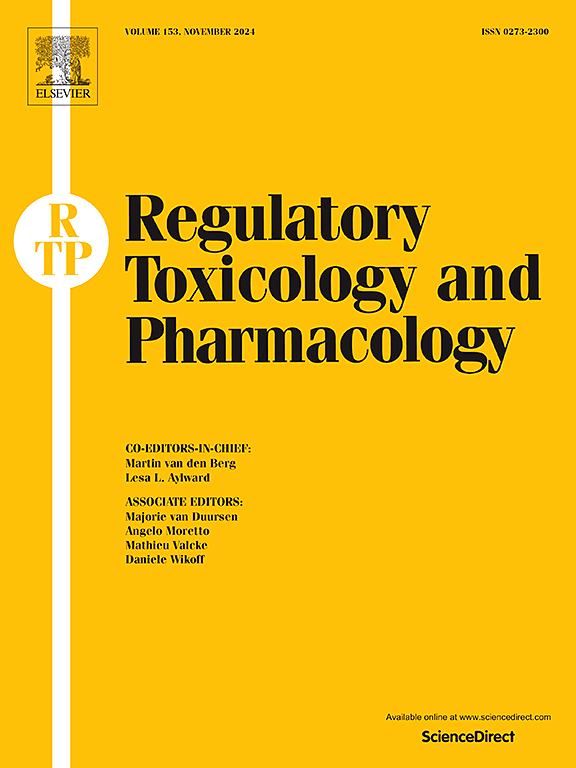枳实粉末90天重复口服毒性及遗传毒性研究
IF 3.5
4区 医学
Q1 MEDICINE, LEGAL
引用次数: 0
摘要
枳实(Aurantii Fructus Immaturus, AFI)已被广泛用作促进健康和治疗各种疾病的中草药,但对其毒性的研究却很少。在此,我们对粉状AFI进行了一般毒性和遗传毒性研究。AFI粉对SD大鼠的致死剂量50% (LD50)均为4000 mg/kg。在为期28天的反复口服毒性研究中,0、125、250、500、1000和2000 mg/kg/天的AFI粉末显示出一些偶发的变化,包括会阴区域脏污、毛发脱落和体重减轻。然而,这些变化不被认为与治疗有关,因为这些值在控制范围内,而且反应不依赖于剂量。在为期90天的重复口服毒性研究中,大鼠服用0、125、250、500、1000和2000 mg/kg/天的AFI粉,恢复期为4周,也没有显示出与治疗相关的毒性结果,尽管一些终点显示出显著的变化,如皮毛脱落、MCH和MCV水平升高以及肝脏重量增加。因此,AFI粉在大鼠体内的未观察到不良反应水平(NOAEL)为2000 mg/kg/d。最后,三组遗传毒性试验表明,AFI粉末不是遗传毒性物质。本文章由计算机程序翻译,如有差异,请以英文原文为准。

Ninety-day repeated oral toxicity and genetic toxicity studies of powderized Aurantii Fructus Immaturus
Aurantii Fructus Immaturus (AFI) has been widely used as an herbal medicine for health promotion and the treatment of various diseases but there is little information on its toxicity. Herein, we performed general and genetic toxicity studies on the powdered form of AFI. The lethal dose 50 % (LD50) of AFI powder in Sprague-Dawley (SD) rats was >4000 mg/kg for both sexes. The 28-day repeated oral toxicity study of AFI powders at 0, 125, 250, 500, 1000, and 2000 mg/kg/day showed some occasional changes including soiled perineal region, loss of fur, and weight loss. However, these changes were not considered treatment-related because the values were within the control range and responses were not dose-dependent. The 90-day repeated oral toxicity study with a 4-week recovery period of AFI powders in rats at 0, 125, 250, 500, 1000, and 2000 mg/kg/day also showed no treatment-related toxicity outcomes, although some endpoints showed significant changes such as loss of fur, increased MCH and MCV levels, and increased liver weight. Therefore, the no-observed-adverse-effect level (NOAEL) of AFI powders in rats was 2000 mg/kg/day. Finally, a battery of three genotoxicity tests showed that the AFI powder was not a genotoxic material.
求助全文
通过发布文献求助,成功后即可免费获取论文全文。
去求助
来源期刊
CiteScore
6.70
自引率
8.80%
发文量
147
审稿时长
58 days
期刊介绍:
Regulatory Toxicology and Pharmacology publishes peer reviewed articles that involve the generation, evaluation, and interpretation of experimental animal and human data that are of direct importance and relevance for regulatory authorities with respect to toxicological and pharmacological regulations in society. All peer-reviewed articles that are published should be devoted to improve the protection of human health and environment. Reviews and discussions are welcomed that address legal and/or regulatory decisions with respect to risk assessment and management of toxicological and pharmacological compounds on a scientific basis. It addresses an international readership of scientists, risk assessors and managers, and other professionals active in the field of human and environmental health.
Types of peer-reviewed articles published:
-Original research articles of relevance for regulatory aspects covering aspects including, but not limited to:
1.Factors influencing human sensitivity
2.Exposure science related to risk assessment
3.Alternative toxicological test methods
4.Frameworks for evaluation and integration of data in regulatory evaluations
5.Harmonization across regulatory agencies
6.Read-across methods and evaluations
-Contemporary Reviews on policy related Research issues
-Letters to the Editor
-Guest Editorials (by Invitation)

 求助内容:
求助内容: 应助结果提醒方式:
应助结果提醒方式:


